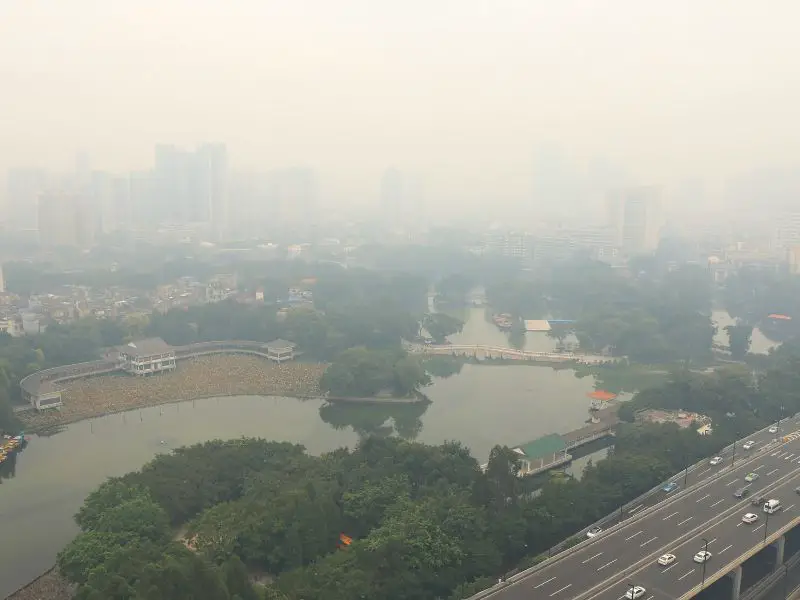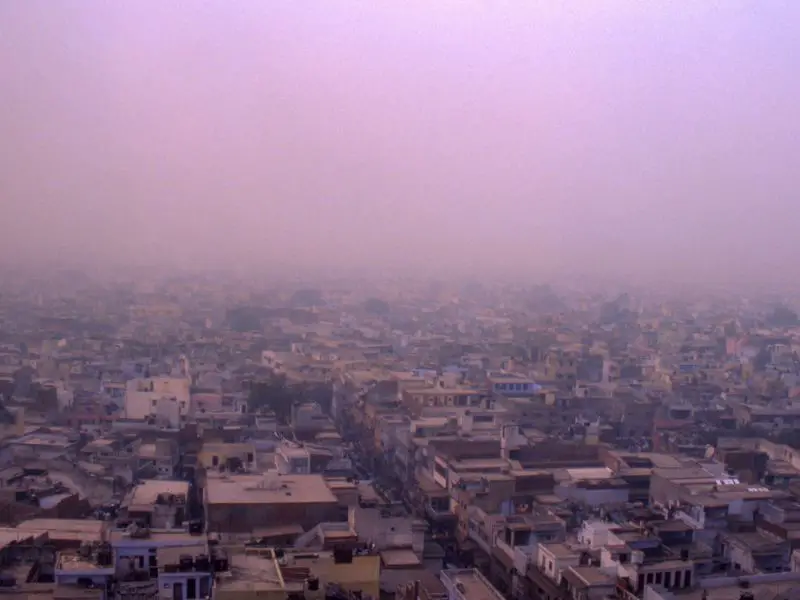Human-caused greenhouse gas emissions are the primary cause of climate change. Their impact on global climate is catastrophic, and it is becoming increasingly imperative that these emissions be decreased to prevent people from putting so much pressure on the planet.
The situation is so dire that the International Energy Agency (IEA) predicts a 130 percent rise in emissions by 2050 if current trends continue.
The largest polluting countries appear to recognize the need to cut emissions, yet despite accords like the Kyoto Protocol, carbon dioxide emissions continue to climb. Almost all of the world’s countries are responsible for the high level of global pollution, but eight stand out from the others.

Understanding Air Quality in the Worst Polluting Countries
Concentration of Particulate Matter and Its Influence on Health
When assessing the worst polluting countries in the world, the concentration of PM particles plays a pivotal role, with the World Health Organization (WHO) evaluating various regions to identify the most polluted places on Earth. In these worst polluting countries, dense industrialization and population contribute to heightened concentrations of harmful particles, exposing the populace to severe health risks and linking long-term exposure to higher death rates.
“Water and air, the two essential fluids on which all life depends, have become global garbage cans.”
Jacques Yves Cousteau
Quality of Air and The WHO Guidelines
Investigating air quality is crucial in identifying the worst polluting countries. A study by IQAir, which included 131 countries and territories, found that only a minimal number, including Australia, Estonia, Finland, Grenada, Iceland, and New Zealand, met the WHO air quality guidelines. These guidelines set the threshold for average air pollution levels at 5 micrograms per cubic meter or less, outlining the ideal conditions, contrary to what is observed in the most polluted countries.
The Industrial Revolution’s Cumulative Carbon Footprint
Historical Emission Rates
The industrial revolution has significantly shaped the emission profiles of the worst polluting countries, with cumulative CO2 emissions from this period being directly related to the 1.2°C of global warming experienced today. The UK, for example, a pioneer of the industrial revolution, was a substantial emitter for a century and has left a lasting imprint on global cumulative emissions.
Emission Analysis: Capita and Absolute
US and China’s Emission Contributions In the discussions about the worst polluting countries, the United States and China are inevitably mentioned, given their significant contribution to both historic and current absolute emissions. However, scrutinizing per capita emissions reshuffles the rankings, placing China lower on the list and showcasing the importance of methodology in emission analyses.
Per Capita Emissions & Methodology Examining the worst polluting countries requires careful consideration of per capita emissions, a parameter heavily influenced by the employed methodology. Unlike cumulative emissions, per-capita figures are not directly indicative of the overall warming, highlighting the need for comprehensive studies on the matter.
Renewable Energy and the Climate Crisis
Moving Away from Fossil Fuels To alleviate the impacts observed in the worst polluting countries, there is a growing emphasis on renewable energy, with companies globally acknowledging the urgency to transition away from fossil fuels. This shift is imperative to mitigate the repercussions of climate change. Some countries have recorded a decrease in emissions, yet it’s not substantial enough to counter the climate crisis or ensure citizen’s health in the most polluted regions.
“Environmental pollution, terrorism, and many other global threats do not stop at borders. We all bear global responsibility and thus need a global identity to enable us to cope with them”
Klaus Schwab
An in-depth understanding of the subjects discussed unveils the complexity of global pollution, emphasizing the significance of concentrating on air quality, realizing the legacies of industrial revolutions, and prioritizing renewable energy. Scrutinizing pollutant concentrations and adhering to WHO’s guidelines could help ameliorate conditions in the worst polluting countries, possibly diminishing the severe impacts of the climate crisis and preserving the health of the inhabitants in such industrialized and densely populated territories.
8 Worst Polluting Countries in the World
1. China
Topping the list of the worst polluting countries, China is the world’s largest carbon emitter. Responsible for the anticipated rise of emissions by 130% by mid-century, the nation’s power plants, transportation hubs, and industrial facilities continuously spew massive amounts of carbon dioxide.
Predominantly concentrated in five provinces, these sectors surpass every other nation in terms of carbon release. This alarming level of pollution has led to cities like Beijing issuing frequent red alerts for environmental pollution. In response, China has enforced policies mandating factories and power plants to curtail their carbon emissions in hopes of mitigating climate change.
2. United States
As the second-largest contributor on the list of worst polluting countries, the USA accounts for over 10% of the world’s carbon emissions. These emissions stem largely from its power sector, which includes nuclear and fossil fuel plants.
A typical American has an annual carbon footprint of 15 tonnes—twice that of the average Chinese. However, the Biden administration aims to reduce greenhouse gas emissions by at least 50% from 2005 levels by 2030, along with intensified efforts to control methane pollution, which has a significantly higher warming potential than CO2.

3. Russia
Russia, another country on the worst polluting countries list, has witnessed a reduction in overall greenhouse gas emissions since 1990. Yet, the nation is slated to release approximately 1.6 billion tonnes of CO2 annually. Climate Action Tracker asserts that Russia’s current policies, climate goals, and funding are “critically insufficient.” Under existing measures, Russia’s cumulative emissions are predicted to either remain stagnant or see an increase until 2030.
4. India
As one of the worst polluting countries, India’s rapid economic growth comes with the downside of rising greenhouse gas emissions. The lion’s share of these emissions arises from its electricity sector, predominantly fueled by coal.
Despite India’s commitment to slash emissions intensity following the Paris Climate Agreement, doubts persist among climate specialists regarding the efficacy of this strategy in buffering the country against global warming. Moreover, despite some advances, recycling remains a pressing concern in India. The nation’s recycling rate lags behind, indicating the vast room for improvement.

5. Indonesia
Indonesia is another rapidly growing country, and it’s now among the worst polluting countries due to a significant increase in its greenhouse gas emissions.
When countries become as wealthy as they are today, they often find themselves on the list of worst-polluting countries. Many of today’s nations were far more environmentally conscious when they were at the development stage of their economy, but as they grow, so do their emissions.
A country’s carbon footprint is often positively correlated with its GDP per capita. Wealthier countries, which are frequently the worst polluting countries, probably have more money to spend on transportation and industrial facilities and less need for manual labor like farming and logging.
Recycling is one area that is hugely lagging behind in Indonesia. The country’s industrial waste and electronic trash account for most of its landfills, positioning them among the worst polluting countries. Alarmingly, they recycle only a small portion of this waste.

6. Japan
Japan is the world’s largest user of fossil fuels and the fifth-highest producer of greenhouse emissions. This is because of its high degree of urbanization and industry that appears to care little for the climate, even if they have outstanding forestry practices and waste management.
Since World War II’s end, Japan has significantly improved its industrial infrastructure. Since 1950, the country has been increasingly developing its heavy industry. Because of the dramatic expansion of industrial production, a significant quantity of pollutants has already been released into the environment each year.

7. Germany
As one of the worst polluting countries in Europe on a per capita basis, the Federal Republic of Germany stands out. With its population of nearly 82 million, this nation, among the worst polluting countries, generates the highest CO2 per capita in the region, at 9.7 tonnes per person each year.
The devastating floods that struck in 2021 brought to light that even one of the worst polluting countries with its wealth and resources is not immune to the repercussions of climate change. However, environmental awareness among Germans is increasing. The Green Party, addressing the concerns of the worst polluting countries, secured 15% of the votes in the General Election of 2021, positioning them as the third major political force in the country.
Recycling, a countermeasure to the challenges faced by the worst polluting countries, has also become a widely adopted practice in Germany. The nation is known to recycle a significant part of its waste, distinguishing itself from other worst polluting countries and marking its spot as one of the most environmentally proactive countries globally.
8. France
The UN study identifies France as the first G7 country to make the list of worst polluting countries. Despite its position, it’s not the only G7 nation on the list of worst polluting countries. The study records a per capita carbon footprint for France of 5.02 metric tons. A report by France24 suggests that this worst polluting country is currently not on track to meet its ambitious goal of being carbon-neutral by 2050.
France’s energy strategy, which contributes to its ranking among the worst polluting countries, has heavily leaned towards nuclear power. As the leading global consumer of nuclear energy on a per capita basis, it accounts for an astonishing 70% of the electrical output of one of the worst polluting countries.
The government of this worst polluting country has, among other technologies, invested extensively in nuclear energy. France stands as the world’s top nuclear energy user per capita, representing 70% of the country’s electric production.
What Is the Leading Cause of C02 Emissions?
Burning coal is the biggest source of CO2 emissions caused by people and industries. Coal has the most carbon out of all the fossil fuels. Coal has been used to power electricity grids worldwide for decades because it is cheap and easy to find. In 2019, more than half of China’s energy came from coal.
Why Is China’s Emissions Roofing?
China is the “manufacturer” of the planet, and a significant portion of its industrial production is powered by coal. Additionally, growing urbanization has led to an increase in the amount of CO2 emissions. Manufacturing of cement and steel, both essential for building infrastructure, is responsible for considerable amounts of carbon dioxide emissions.
In 2018, China’s cement manufacturing accounted for roughly 8 percent of the country’s total carbon dioxide emissions. On the other hand, China is responsible for producing almost fifty percent of the world’s steel.
Author’s Note
The eight countries that lead the world in CO2 emissions are also the greatest economies on the planet. Recycling is valuable because it puts less stress on our planet and ensures that we have clean air and water to consume in the future.
However, it is also important to remember that recycling only reduces a small portion of our overall carbon footprint. For example, if Americans recycle one-tenth of their newspapers, we would have saved 25 million trees each year, and choosing reusable water bottles instead of buying new ones helps reduce the amount of garbage we send to our landfills. Recycling will not solve all of our climate problems alone, but it will make a difference.
One of the main causes of global warming is how we are producing the energy required to power the factories that manufacture the goods we consume on a daily basis. And let’s not forget transportation and agriculture play an important role in climate change too.
Related: Cleanest Cities in The World, 8 Worst Polluted Beaches, 10 Amazing Organizations Fighting Ocean Pollution



;?>/smartquizbuilder/includes/images/sqb-registration-img.jpg)



